- 浏览: 45594 次
- 性别:

- 来自: 上海
-

文章分类
最新评论
-
map521:
很详细,讲的很明白了,感谢楼主的无私。
Spring中集成Quartz的简单配置 -
化蝶自在飞:
留记号,正在用,谢谢
ECShop 2.7.2 邮件服务器设置及“Access is denied”的解决方法 -
mefly:
目前看没什么错,我在用你的,谢谢
jQuery Validate 扩展IP校验 -
xplazy:
buaawhl 写道weiweichen1985 写道无论你需 ...
-
xplazy:
weiweichen1985 写道值得高兴的是,无论你需要什么 ...
Subversion & TortoiseSVN: Installed and started on Windows 2003 server and local machines
Subversion 使用介绍
Introduction
In this article I will walk through the process of installing Subversion and getting started using this very useful version control tool. I chose Subversion based on its ease of use and understanding, the documentation provided is very easy to understand and navigate through, also you can't beat the cost - FREE.
I've laid out this article in a step by step method using the practices that I feel give the best results for my situation, there are always ways to customize this process and I will mention some of these as the steps progress.
Notes:
To clarify some terminology -
Some of the pictures in this article have been resized.
I've written this article with the beginner in mind, some of the steps and images may seem redundant and unnecessary but I included them so that there would be as little confusion as possible.
The names and aliases used in this article can and probably should be changed to meet your needs.
*There is a One-Step process that installs SVN, TSVN, sets up the service, downloads the documentation, and creates the first repository - http://svn1clicksetup.tigris.org/ I didn't take this route because I wanted a little more control and understanding of what I was putting on my machines.
Quick Reference Links
- I. Documentation Download
- II. Subversion Download
- III. Subversion Executable
- IV. Setting up the SVN log
- V. Setting up SVN as a service
- VI. Uninstall the SVN service
- VII. Create a repository on the server with SVN command line
- VIII. Install TSVN on the server and create a repository
- IX. Install TSVN on client machines
- X. Loading source code into a repository using TSVN
- XI. Creating a local working directory from a repository
- XII. Committing changes back to the repository
Now to Business
I. The first thing I recommend is getting yourself a copy of the most recent Subversion Manual. This will be good for future reference when you want to get more involved with the finer points. http:\\svnbook.red-bean.com\ , I recommend the .pdf version as this will allow you to save a copy to your desktop, you can also download a one page HTML of the same documentation.
II. Once you have a copy of the manual on your local desktop it's time to get started with the install. RDC (Remote Desktop Connect) to the server, or log into the server directly and navigate out to the SVN download page http:\\subversion.tigris.org\servlets\ProjectDocumentList?folderID=91
a. From this site select the most recent version of the SVN .exe installer for Windows (svn-1.4.2-setup.exe at the time of this article)

III. Run the .exe on the server

a. Follow the prompts to install SVN on the server

b. Accept the license agreement
c. Select the destination of SVN on the server:

d. Accept the Start menu shortcut 'Subversion'

e. Allow the documentation links to be posted to the server

*Note – At the time of this article the documentation that is posted is from SVN version 1.3, but most of the data presented is current with the exceptions of the latest additions. The documentation is still good for use as a reference.
f. Click 'Install' -> 'Next' -> Finish, and you've just installed SVN to the server. Easy, huh?
IV. The next step in the installation process will set up the log editor for SVN
a. Click Start -> select the Control Panel -> System
b. Select the 'Advanced' tab -> Environment Variables

c. Click 'New' under System Variables

d. Set the variable name to SVN_EDITOR
e. Set the Variable Value to C:\Windows\notepad.exe

i. This is the default text editor for logs in SVN
f. Click 'OK' out of the menus
V. Setting up SVN as a service on the server
a. First download the .zip file that contains the needed files – http:\\www.stanford.edu\~bsuter\subversion-setup-guide\SVNService.zip

b. Open the zip file and select the file SVNService.exe

i. Click Edit -> Move to Folder -> Browse to C:\Program Files\Subversion\bin


**It's absolutely critical that this file be place here as it needs svnserve.exe to run properly. The other files are not needed for the service to run but you can extract them to the bin file as well for a reference.
c. Open a Command Window
d. Enter 'svnservice –install –daemon - - root "d:\AppRepositories

i. This sets the service to run in the background (daemon) and sets the root directory to the file that holds the repositories (d:\AppRepositories).
e. SVN is now set up as a service

f. Now that SVN is set up as a service on the server you can access it programmatically from the command line and later the TSVN interface using the following format - svn://(ServerName)/(RepositoryName)/ProjectSource/trunk
**Notice that the actual drive (D:/) as well as the folder holding the repositories (AppRepositories) are missing from the command, this is now using the 'root' that was specified in the service creation command.
g. Now to further configure the service go to Start -> Control Panel -> Administrative Tools -> Services

h. Navigate down to SVNService and double click the service. Change 'Startup type:' from manual to Automatic


i. Now SVN will start every time the server boots up.
j. Back in the services screen, click 'Start' in the upper left of the right pane OR click the 'play' icon in the menu tool bar to start the service

k. Close the window and you've implemented SVN as a service.
VI. Uninstall the SVN service
a. Open a Command Window
b. Enter 'svnservice –remove'

c. This command will both stop and remove the service from the directory
VII. Creating a repository using the SVN command line
a. First thing, open a command prompt window
b. Next create a folder on the D: drive to house all the repositories
i. 'mkdir d:\AppRepositories'

c.
Within this folder place all project repositories.
**It
is possible to place several projects within the same repository but I
would not recommend this as there is a chance to get some of the code
mixed or replaced inadvertently. It might be beneficial to do this if
the repositories that will be grouped are similar in style or use the
same resources.
d. Also create a folder within the AppRepositories directory named 'config'. This folder will hold the shared passwd file for all subsequent repositories. **This step is not necessary but it makes manageability much easier.
i. 'mkdir d:\AppRepositories\config'

ii. **We'll put the passwd file into this new folder a few steps down the road, when we set up the repositories' configuration.
e. Now create the first repository, I recommend using the same name for the project as the repository name.
i. 'svnadmin create d:\AppRepositories\((ProjectName))'

f. Once the repository has been created we'll need to create another folder within the repository itself to hold the working directory of the project. I've added the subsequent folders for my own benefit as I feel that this method makes it easier to understand.
i. 'svn mkdir file:\\\d:\AppRepositories\((ProjectName))\ProjectSource'

ii. This subfolder is needed to house the trunk, branches, and tags folders that actually hold the working code. The main repository ((ProjectName)) will still handle the versioning of the project. This folder and those created in the next few steps will need to be created for all repositories.
iii. The trunk folder is where you will store the source code, or working code. The tags folder is used to hold 'snapshots' of the project, i.e. to present version 1.0.22. The branches folder is used to hold the branches of the project, basically the same code but with different functionality, i.e. taking the application in a new direction.
g. Upon creation of the 'ProjectSource' folder a log file will appear in notepad

**On the top line above the '- -' enclosed line enter a description of the action, i.e. 'Initial creation of the projectsource folder to hold trunk, branches, and tags source folders.'
h. Click File -> Save -> close notepad
i. Once the log has been saved and closed the command prompt will display 'Committed revision 1'. Each subsequent change made will be a revision to the repository.

j. Now create the trunk, branches, and tags folders
i. 'svn mkdir file:\\\d:\AppRepositories\((ProjectName))\ProjectSource\trunk'


**On the top line of the log file above the '- -' enclosed line enter a description of the action, i.e. 'Initial creation of the trunk folder.'

ii. This is revision 2
iii. 'svn mkdir file:\\\d:\AppRepositories\((ProjectName))\ProjectSource\branches'


**On the top line of the log file above the '- -' enclosed line enter a description of the action, i.e. 'Initial creation of the branches folder.'

iv. This is revision 3
v. 'svn mkdir file:\\\d:\AppRepositories\((ProjectName))\ProjectSource\tags'


**On the top line of the log file above the '- -' enclosed line enter a description of the action, i.e. 'Initial creation of the tags folder.'

vi. This is revision 4
k. All the necessary folders are now created and in place. The next step is to configure access to the repository. **This step can also be done right after creating the repository
l. Open an explorer window and browse to D:\AppRepository\((ProjectName))\conf
**Note: you will not see the files just added in the explorer window (ProjectSource, trunk, branches, tags) but not to worry they are there but stored in the repository at their respective revisions and still available for access.

m. With the conf file open make a copy of the passwd file and paste it into the config file of AppRepositories that we created earlier.
i. **This step is not necessary, each repository can have its own list of users with their passwords. If you elect to use this method skip to step r.


n. Open the svnserve.conf file.
**If prompted to select which application to view this document in, choose notepad.
o. Under the [general] section, uncomment the auth-access, anon-access, and password-db lines.
i. Delete the '#' symbols, be sure to leave no spaces on the line before the start of the text.

p. Set password-db = '..\..\config\passwd'. This will set the authentication path to the shared passwd file.
q. Click File-> Save -> close the window
r. Now, open the passwd file in the config folder. **When prompted select notepad as the application to use to view the file.
s. Under the [users] section delete the sample users
t. Enter the users that will have access to this repository in the form of username = userpassword. **again make sure that there are no spaces before the first character of text.

i. This will be the only time other than adding new users that you will need to modify the \config\passwd file. Unless of course you're modifying the passwd file for each repository.
u. Click File -> Save -> close the window.
VIII. Create a repository using TSVN on the server
a. TSVN is not necessary at the server level as it is pretty much an end user tool but for the sake of completeness I'm including it here. I personally feel that creating repositories with TSVN is easier than using the command lines.
b. First go to http:\\tortoisesvn.net\downloads
c. Download the latest version of TSVN to the server (1.4.3.8645 at the time of this article)
d. Run the 32-bit installer or 64-bit if this is how your server is configured.

e. Accept the license agreement -> Click Next
f. Accept the default icon tree and location of TSVN -> Click Next

g. Click Install
h. When finished installing unselect the 'View Change Log' and click Finish.
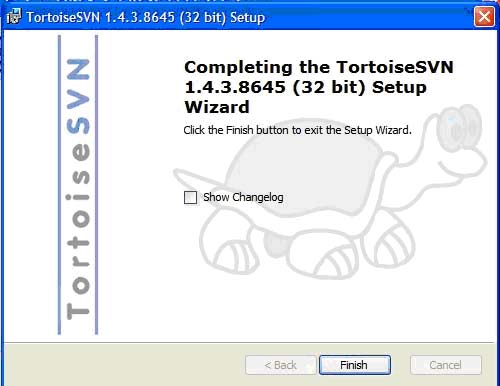
i. TSVN requires the system to reboot, close all windows and then select 'Yes' to reboot now
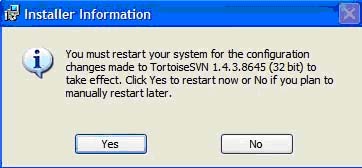
i. Once the system has successfully rebooted, RDC back into the server or reconnect into the system and open an explorer window.
j. Navigate out to the D:\ drive and right-click in the right pane of the window and create a new folder that will house all the repositories. Name the folder 'AppRepositories'.

k. Open the folder and repeat the folder creation process, this time name the folder the same as the project you intend to version. i.e. 'BrushLog'. Also create a folder with the name 'config', that will hold the shared passwd file.

l. Right-Click on the project folder and roll down to TortoiseSVN> -> and click 'Create repository Here'
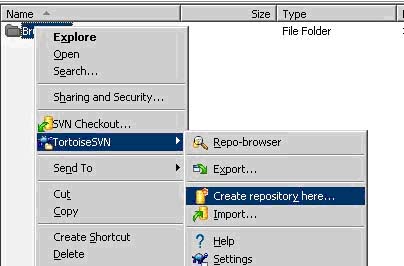
m. In the first prompt window select 'NativeFileSystem(FSFS)
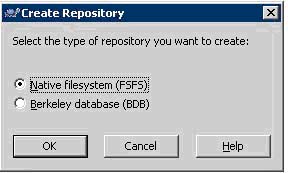
i. **I highly recommend using this system for its flexibility and compatibility
n. Click OK, and the repository is now created.

o. Next create the working directory folder by opening the repository folder and right-clicking the right pane of the window and create a new folder that will house trunk, branches, and tags folders. Name the folder 'ProjectSource'.

p. Open the ProjectSource folder and in the right window create three new folders named: trunk, branches, and tags.

q. Open the svnserve.conf file. **If prompted to select which application to view this document in, choose notepad.

r. Under the [general] section, uncomment the auth-access, anon-access, and password-db lines.
i. Delete the '#' symbols, be sure to leave no spaces on the line before the start of the text.

s. Set password-db = '..\..\config\passwd'. This will set the authentication path to the universal passwd file.
t. Click File-> Save -> close the window
u. Now we will need to configure the authentication for the repositories. Open the conf folder in the repository you just created and copy the passwd file to the config folder under the AppRepositories directory.


v. Open the passwd file, when prompted select notepad as the application used to view the file.

w. Under the [users] section delete the sample users. Be sure to leave no spaces between the text and the start of the line. Enter the name and password for the users that will have access to the repositories in the form of username = userpassword.

i. This is the only time that you will need to change this file with the exception of adding new users. Unless you've elected to use separate passwd files for all repositories.
x. The process of creating a repository is now completed using TSVN, note also that in using this method no revisions were completed while adding the files. Also the files are visible within the explorer window.
IX. Install TSVN on client machines
a. First go to http:\\tortoisesvn.net\downloads
b. Download the latest version of TSVN to the computer (1.4.3.8645 at the time of this article)
c. Run the 32-bit installer or 64-bit depending on the machine

d. Accept the license agreement -> Click Next
e. Accept the default icon tree and location of TSVN -> Click Next

f. Click Install
g. When finished installing unselect the 'View Change Log' and click Finish

i. TSVN requires the system to reboot, close all windows and then select 'Yes' to reboot now
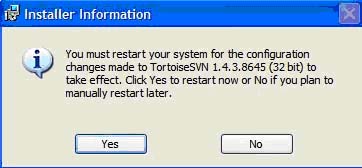
X. Loading source code to a repository using TSVN
**Note: Before going on be sure you've completed section IX, a repository must be in place to import
a. Open an explorer window and browse to the folder containing the source code
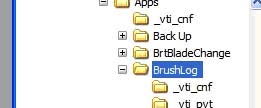
b. Right-click the folder -> TortoiseSVN> -> Import
i. When using TSVN import(to the server) in this case means the same as export(from the client). This confused me in the beginning.

c. Enter 'svn:\\(servername)\(NameOfRepository)\ProjectSource\trunk' into the Url of repository. You can add a description of the import action in the Import Message window, i.e. Initial import of the (ApplicatioName) source code.

d. At the prompt enter the username and password entered into the passwd file from the repository conf file. This only needs to be done once per session, SVN and TSVN will remember the entries for the duration of the session. Unless you've used separate passwd files, then you'll have to repeat this for each new repository.

e. Click OK and all the files are loaded into the repository and committed at the next revision number (revision 1(TSVN) or 5(SVN command line) depending on the method used to create the repository)

**Note: The total number of files imported is also displayed at the bottom of the window.
XI. Creating a local working directory from a repository
a. Open a windows explorer and browse to the C:\ drive, right-click the right pane and create a new folder. Name the folder SVN.
b. Open the SVN folder, right-click in the right pane and create a new folder with the same name as your repository
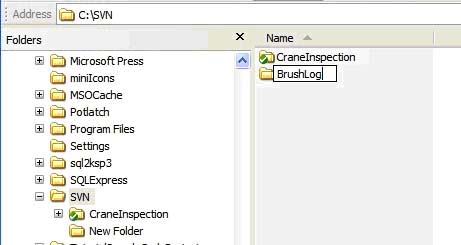
c. Right-click the new folder -> SVN Checkout
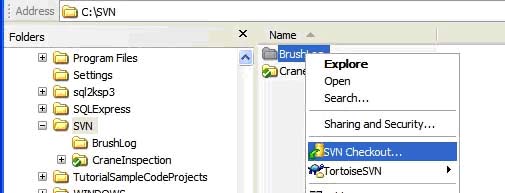
d. In the 'Url of repository' enter 'svn:\\(ServerName)\(RepositoryName)\ProjectSource\trunk'

**Note: In the bottom section of the window it is possible to specify a previous revision of the project by specifying a revision number. The default is the latest committed version.
e. Click OK
f. This adds all the source code at the current(most recent) revision. The window shows the total number of files added to your directory (Added: ##) and the revision number.

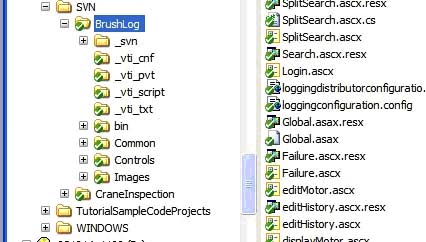
**Note: Every file in this folder has a green check icon on it, this means that this file appears as is from the repository. This icon will change if the file is modified to a red '!' and will remain thus until the file is committed back to the repository on the server.
g. You've now got a working copy of the source code that you can modify, change, or reinvent at your leisure with no worries about 'accidentally' losing everything.
XII. Committing changes back to the repository
a. When you're ready to save your changes back to the repository browse out to the working directory and right click the folder -> SVNCommit

**Notice that all the changed files are marked with a red '!', this is just TSVN's way of letting you know you've done some work.
b. TSVN allows you to select which file you'd like to commit back into the repository, either a single control, many code pages, or the entire working code.
You can commit any files you choose (not always all of them), but when you commit the files you selected, they are all committed or not at all (When an error occurs for example). *(SDragon42, 3/23/07)*
i. If you are working on a project as part of a team and other members have checked out and checked back in code before you complete yours and your code is not compatible TSVN will display an error. At this point I recommend right-clicking the folder -> TSVN -> Check-for-Modifications. For more on the capabilities of TSVN see the manual.
** Simply checking for changes made to the files is not sufficient to have a compatible working compilation, an Update is required on the working copy to get the latest code from the repository. *(SteveKing, 3/23/07)*
**Note: A cool feature of TSVN is that when you're ready to commit the changes back to the repository all the files that are being sent appear in the lower part of the commit window, and by double-clicking a particular file you can see what exactly was changed between revisions.
ii. Click OK

iii. Enter your username and password from the passwd file
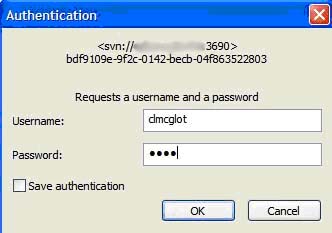
iv. All the changed files are now updated in the repository and loaded into the next revision. The revision number is displayed in the window. Each revision holds all the files for each project; the difference is what is displayed below.

Conclusion
Up to this point you have come far enough to use the basic functionality of SVN with TSVN. Of course there is lots more that can be done with SVN and maybe I'll cover that in a later article, but until then everything is in the documentation that you've downloaded.
Getting the ball rolling is the hardest part of using SVN, once you start incorporating it into your development cycle you'll realize just how easy and beneficial these tools are.
Credit where Credit is due
This article would not be what it is without some help and guidance from some who are more experienced and knowledgeable than myself. First let me thank the CP community for being the supportive and encouraging place that it is for programmers. Second I have a couple shout outs to two individuals that helped me to get not only this article off the ground by providing very poignant research direction but also to complete the work that led to the article in the first place.
-
Hans Dietrich - for providing very well written articles and suggestions
-
code-frog - for getting me started in the right direction
History
Initial article submission - version 1.0
Errors in text changed - version 1.1
Grievous lack of acknowledgement taken care of - version 1.2
License
This article has no explicit license attached to it but may contain usage terms in the article text or the download files themselves. If in doubt please contact the author via the discussion board below.
A list of licenses authors might use can be found here
增加生成server 的windows command.
sc create svnservice4 binpath= "\"d:\Program Files\svn-win32\bin\svnserve.exe\" --service --listen-port 9999 -r E:\personal\live\rep" displayname= "SVNService4" depend= Tcpip





相关推荐
TortoiseSVN is an easy to use SCM / source control software for Microsoft Windows and maybe the best standalone Subversion client there is. It is implemented as a Windows shell extension, which makes ...
VisualSVN for Visual Studio 2017 ... It can be installed side-by-side with older version. Compiled with Apache Subversion 1.9.7. Supports all editions of Visual Studio. 支持所有版本Visual Studio
它兼容多种客户端工具,如TortoiseSVN、Visual Studio插件等,使得开发者能够在熟悉的环境中进行版本控制操作。 总的来说,VisualSVN Server 2.1.7作为一款优秀的Subversion服务器解决方案,以其易用性和强大的管理...
We use SubVersion server and you need to use a subversion client such as TortoiseSVN. Once your SVN client is installed, for ICS-V6 you can browse to svn://svn.overbyte.be/ics or ...
We use SubVersion server and you need to use a subversion client such as TortoiseSVN. Once your SVN client is installed, for ICS-V6 you can browse to svn://svn.overbyte.be/ics or ...
访问Apache Subversion官网,找到对应操作系统的客户端工具,如TortoiseSVN(Windows)或命令行工具。 #### 3.3 安装 1. **Windows**:下载.msi安装文件,双击安装。 2. **macOS/Linux**:使用包管理器安装,如`...
5. **TortoiseSVN**:版本控制系统Subversion的一个图形前端,用于代码版本管理。 6. **Apache Tomcat 5.5.20**:流行的开源Java Servlet容器,用于部署和运行JSP应用。 #### 安装步骤: 1. **安装Eclipse**:首先...